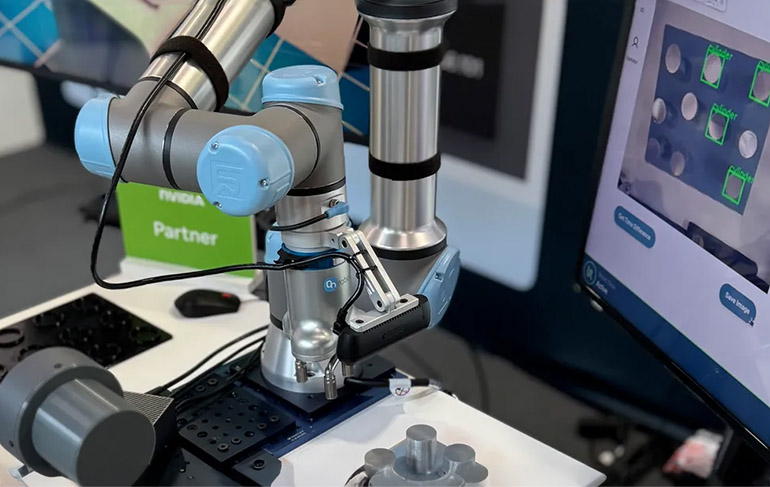|
Listen to this article |

The UR AI Accelerator toolkit includes reference hardware and software. Source: Universal Robots
The latest advances in artificial intelligence promise to improve robot capabilities, but engineers need to bring the technologies together. Universal Robots A/S last week announced its UR AI Accelerator, a hardware and software toolkit to enable the development of AI-powered collaborative robot applications.
The UR AI Accelerator is an extensible platform for developers to build commercial and research applications, said the Odense, Denmark-based company. It is also intended to accelerate research and reduce the time to market for AI products, Universal Robots said at ROSCon.
“If you’re building solutions on our platform, it will decrease your time to deployment while also de-risking the development of AI-based solutions,” stated James Davidson, chief AI officer at Teradyne Robotics, parent organization of Universal Robots.
“People spend an enormous amount of time on the connective tissue of these systems — selecting hardware, finding compute and cameras, and on compliance,” he told The Robot Report. “On the software side, developers have to decide what model to use and how to optimize it with the hardware.”
“We’ve pulled that together in a platform for reference applications and libraries to build solutions quickly,” Davidson added. “That way, developers can choose what toolsets and languages they want to use and spend their time on high value-added capabilities.”
AI Accelerator runs NVIDIA models for faster deployment
NVIDIA Isaac libraries and models running on the NVIDIA Jetson AGX Orin system on module bring AI acceleration to Universal Robots’ PolyScope X software. Isaac Manipulator can enhance cobot performance, and the toolkit includes the new Orbbec Gemini 335Lg 3D camera, the company added.
Universal Robots said the accelerator provides built-in demonstration programs to enable pose estimation, tracking, object detection, path planning, image classification, quality inspection, state detection, and more. While the UR+ ecosystem offers compatible hardware for cobot applications, the AI Accelerator provides functionality options.
“The AI Accelerator is fundamentally designed to make robots easier to deploy for inspection, picking, and other functions,” said Davidson. “We’re trying to bring up the utility of solutions to be leveraged more quickly by partners.”
“If you’re a roboticist, with component AI for reference projects, you can do dynamic motion planning and obstacle awareness,” he noted. “If you’re an AI developer, we have robotics components through ROS with NVIDIA wrapped around it, and you can go to our ecosystem.”
Universal Robots focuses on cobot app dev
For its AI Accelerator, Universal Robots identified enablers that it could put together to solve application problems by moving up the stack, Davidson explained.
“We vetted the AI components and designed reference examples for the hardware and software package,” he said. “The time saved depends on the application. This can have a huge impact on things like inspection or palletizing. Building a foundation model is very different from learning physical AI or integration.”
The platform is designed to be flexible. It can use simulation and digital twins, but it doesn’t require them, said Davidson.
“Think of simulation as addressing problems — synthetic data generation can bridge the sim-to-real gap, primarily in visual applications,” he said. “We are hopefully enabling customers to go further into the physical side.”

Universal Robots and partners such as NVIDIA offer an AI Accelerator to ease cobot development. Source: Universal Robots
AI Accelerator, PolyScape X just the first steps
Universal Robots plans to show systems developed with its platform and AI at its PolyScape X Festival next month. The company, which claimed that it has sold more than 90,000 cobot arms worldwide, said PolyScape X is compatible with its e-Series and UR20 and UR30 cobots.
Davidson added that AI is starting to enable robots to be more reliable and to perform a wider range of tasks.
“Instead of programming a robot for piece picking, we’re moving to functional manipulation and more complex assembly tasks,” he said. “For a robot to grab a cup, it needs to handle multisensory inputs, such as visual and tactile data. Feedback and closed-loop systems will be key.”
“With our objective to take physical AI to an entirely new level, AI Accelerator is just the first to market of a series of AI-powered products and capabilities in UR’s pipeline, all with the focused goal of making robotics more accessible than ever before,” said Davidson. “We’re engaged with customers and partners.”
“The hype around AI is starting to die down, but all agree that it is continuing to make progress,” he said. “We’re at an inflection point. When I asked at trade shows two to three years ago how many people were using AI, only one or two people raised their hands. Now, 75% of people raise their hands.”
